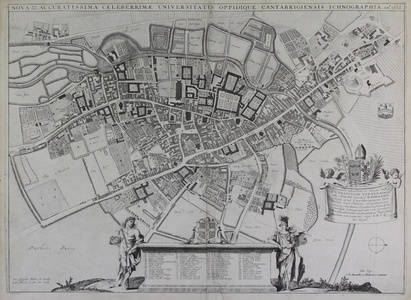| Method | Copper engraved |
| Artist | Loggan, David |
| Published | Dav. Loggan Delin. et Sculp. cum Privil. S.R.M. 1688 |
| Dimensions | 408 x 525 mm |
| Notes |
Loggan's rare and celebrated map of the city and university of Cambridge, from Cantabrigia Illustrata. Sive omnium celeberrimæ istius universitatis... Cambridge: Quam proprijs sumptibus typis mandavit & impressit Cantabrigiæ. As in Loggan's earlier Oxonia Illustrata, his much rarer series of Cambridge plans are executed with extraordinary and accurate detail, and imply a considerable amount of time spent on the study of the buildings and on the preparation of the plates. Loggan's map of Cambridge is the first to show the city vertically from above, unlike the earlier maps of Fuller and Hollar which render the city from a bird's eye perspective. The city had also expanded substantially since the Hollar map of 1640, and Loggan's plan is the first to show much of the remodelling and new building which occurred during the second half of the seventeenth century, at Trinity, St Catherine's, Gonville & Caius, St John's, Emmanuel, and Christ's College. The map is further embellished by a numbered key flanked by Apollo, patron of the Arts, and Minerva, goddess of Wisdom, as well as a dedication to the Revd. Francis Turner held up by a pair of winged cherubs. Loggan's Cambridge views have been much less reviewed by bibliographers. The best piece still, although discursive, is the introduction and the captions to each plate by J.W. Clark in the Macmillan and Bowes reprint of 1905. In the year following the publication of 'Oxonia Illustrata' Loggan was in Cambridge printing Wren's design for the Library of Trinity. This employment may have prompted him to turn his attention to Cambridge. Clark thought it 'not difficult to prove that 'Cantabrigia Illustrata' was definitely begun in 1678 or 1679, if not earlier, and that it could not have been published before 1690'. The former proposition he demonstrates by internal evidence. He shows that it was published by 1690 using entries in the account books of at least two colleges. Wing records an edition of 1688 (Wing L2836), with four UK locations, and one US. David Loggan (1635–1692) was born in Danzig in 1635 and came to England around 1653. By 1665 he was living in Nuffield near Oxford and in 1669 was appointed engraver to the University. In 1675 he married and became a naturalised citizen. Condition: Central vertical fold as issued, tear repairs to centrefold and key bottom, areas of thinning to centrefold, time toning to sheet edges. |
| Framing | mounted |
| Price | £1,675.00 |
| Stock ID | 48021 |

